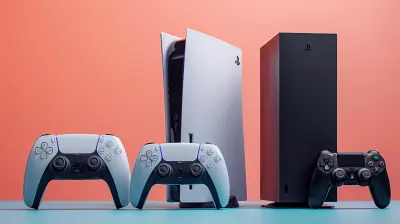31 March 2025
Virtual reality (VR) has been around for quite some time now, and it's only getting better. With VR hardware improving at a lightning pace, gamers are spoilt for choice. One of the hot topics in the VR world right now is the PlayStation VR2 (PS VR2). Sony's latest take on virtual reality aims to deliver an immersive, next-gen experience for PlayStation 5 owners. But how does it measure up when compared to other major VR platforms out there, like the Oculus Quest 3 or Valve Index? Let’s dive into the nitty-gritty and see where the PS VR2 shines and where it might falter.

What Makes PlayStation VR2 Stand Out?
First off, let’s talk about what makes the PS VR2 special. Sony has upped its game with this iteration, packing in features that rival high-end PC VR systems. It’s designed exclusively for the PS5, meaning it can leverage the full power of the console. But is that enough to carve out its space in a highly competitive market?Here’s what you get with the PS VR2:
1. Top-Tier Visuals and Performance
The PS VR2 boasts stunning 4K HDR visuals with a resolution of 2000 x 2040 per eye. That’s nothing to laugh at—it’s legit one of the best displays you’ll find in a consumer VR headset. Combined with a 120Hz refresh rate, the visuals are buttery smooth, reducing motion blur and increasing immersion.Compare that to the Oculus Quest 3. While the Quest 3 does offer impressive visuals for a standalone headset, the PS VR2’s tethered design allows for a significant jump in graphical fidelity. It’s pulling from the PS5’s raw power, which gives it the edge for more demanding games.
On the other hand, the Valve Index still holds its ground with a high refresh rate and field of view, but it’s more PC-dependent and doesn’t quite match the VR2’s HDR visuals.
2. Sense Controllers Are a Game-Changer
The new PS VR2 Sense controllers are a massive improvement over the aging PlayStation Move controllers used in the original PS VR. They come with haptic feedback, adaptive triggers (just like the DualSense PS5 controller), and finger touch detection. This combination makes interactions in virtual environments feel incredibly lifelike.If you’ve ever used the Valve Index controllers (often called "knuckles"), you’ll know how amazing finger tracking can be. The PS VR2 Sense controllers aren’t far off from that. They’re like having your hands digitized and dropped into the game world.
Against the Oculus Quest 3’s controllers? Well, let’s just say the Quest’s controllers are functional, but they don’t match the premium feel or advanced features of the PS VR2’s.
3. Eye-Tracking Technology
Eye-tracking is where the PS VR2 really flexes. The headset uses eye-tracking to enhance gameplay and optimize rendering through a technique called foveated rendering. Basically, it focuses the processing power on where you’re actually looking, keeping everything sharp while saving performance in your peripheral vision.This is a feature you won’t find on most standalone headsets like the Quest 3. Even the high-end Valve Index lacks built-in eye-tracking. So, it’s safe to say Sony is setting the pace here.
4. Immersive Features
The PS VR2 doesn’t stop at visuals and controllers. It also packs in headset haptics (yes, the headset itself vibrates!), 3D audio, and an inside-out tracking system that eliminates the need for external cameras.The haptic feedback is a standout because it adds another layer of immersion that you don’t find in many other headsets. For instance, if an explosion goes off nearby in-game, you might feel a subtle vibration in the headset. That’s some next-level immersion! 
Where Does PS VR2 Fall Short?
Of course, no piece of tech is perfect. The PS VR2 does have its downsides, and they might be dealbreakers for some people.1. Tethered Design
One of the most significant drawbacks of the PS VR2 is its reliance on a wired connection. Yep, you’re tethered to your PS5 via a single USB-C cable. While the cable is less cumbersome than the original PS VR’s breakout box and multiple wires, it’s still a step behind competing standalone headsets like the Oculus Quest 3.If you’re someone who loves the freedom to move without being tied down, the Quest 3 might be the better choice. Sure, you sacrifice some graphical fidelity, but the wireless freedom is a big win for accessibility and convenience.
2. No PC Support
Here’s a biggie: the PS VR2 is designed exclusively for the PlayStation 5. While this tight integration ensures a great user experience, it also limits the headset’s ecosystem. You can’t hook it up to a PC (at least not officially), which means no access to the vast library of PC VR games on platforms like SteamVR.Compare this to the Valve Index or even the Quest 3 (when used in PCVR mode), and the PS VR2 starts to feel a bit restrictive. PC gamers aren’t going to ditch their libraries just to switch to the PS VR2.
3. Game Library
Speaking of libraries, the PS VR2 is still in its infancy when it comes to games. Yes, there are some fantastic titles like "Horizon Call of the Mountain" and upgraded versions of PS VR classics, but the catalog doesn’t yet rival the extensive libraries available on PC VR or even standalone Quest platforms.Sony has promised plenty of exclusive content, but gamers might be hesitant to invest in a headset without a guarantee of ongoing support and killer titles. 
How Does PS VR2 Compare to Other Major VR Platforms?
To sum it up, here’s a quick head-to-head comparison of the PS VR2 against other big players:| Feature | PS VR2 | Oculus Quest 3 | Valve Index |
|-----------------------|------------------------|----------------------|----------------------|
| Resolution | 2000 x 2040 per eye | 2064 x 2208 per eye | 1440 x 1600 per eye |
| Refresh Rate | 120Hz | 120Hz | 120Hz (up to 144Hz) |
| Tracking | Inside-out | Inside-out | External base stations |
| Controllers | Sense Controllers | Touch Plus | Knuckles |
| Platform | PS5-exclusive | Standalone/PC | PC-only |
| Price | ~$549 | ~$499 | ~$999+ (with PC) | 
Who Should Buy the PS VR2?
So, is the PS VR2 worth it? Well, it depends on who you are.If you already own a PlayStation 5 and want the ultimate VR experience for gaming, the PS VR2 is a no-brainer. It’s packed with cutting-edge features, and the integration with the PS5 ensures a seamless and polished experience.
But if you’re more of a PC gamer or someone who values standalone convenience, you might want to look elsewhere. The Valve Index is still king for hardcore PC enthusiasts, and the Oculus Quest 3 offers unmatched portability.
Ultimately, the PS VR2 is an excellent choice for PS5 owners looking to dip their toes into next-gen VR without breaking the bank on a high-end PC setup.






Blaze McWain
Great insights! Excited to see how PSVR2 evolves further.
April 18, 2025 at 2:40 AM